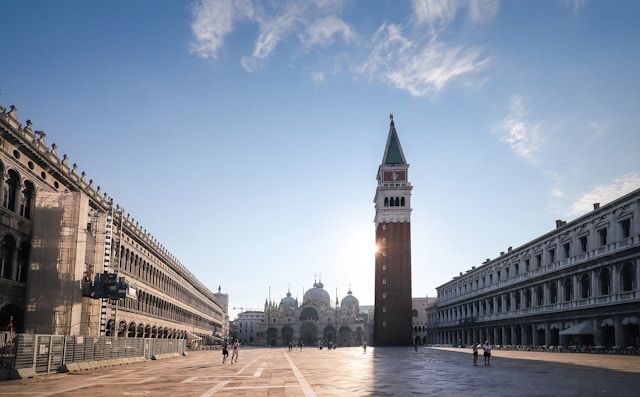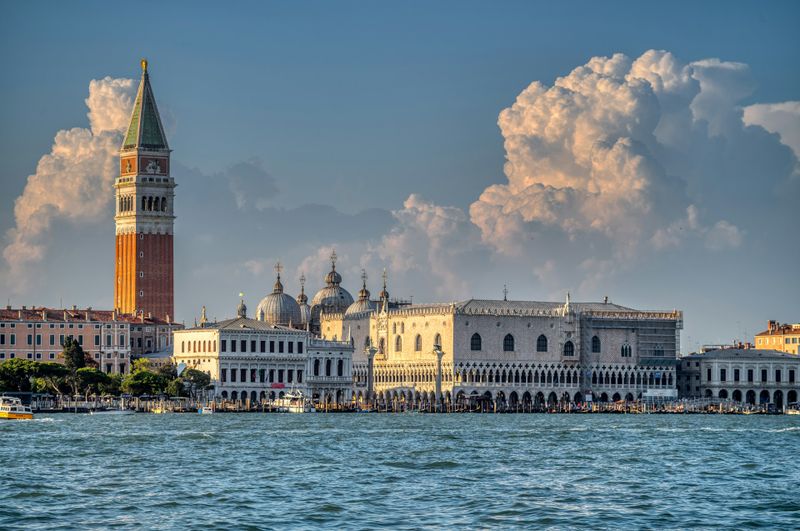Hey travelers, today we’re talking about one of the most iconic symbols of the Serenissima: Bell Tower Venice, aka the famous St Mark’s Campanile.
In this guide signed Venice Insider Guide, we’ll discover all about this beautiful tower: its history, architecture, curiosities and practical information to visit it.
If you’re planning a trip to Venice, you can’t miss this wonder. Get ready to climb up and enjoy a breathtaking view that will leave you breathless (and not just because of the height!).
Bell tower Venice

The "bell tower" of Venice is definitely one of the most photographed and loved landmarks of the city. Located in the majestic St Mark’s Square, it dominates the Venice skyline with its tall height and elegant silhouette.
But this is not the only bell tower in the city: there’s also the one on St George’s Island, which is definitely worth a visit.
The word of the day is “look up”. Every angle offers a new perspective on this fascinating tower, witness to centuries of Venetian history.
Bell tower Venice (St Mark’s Campanile)

The Bell tower Venice (or St Mark’s Campanile Venice as many tourists search online) is the tallest building in Venice: 98.6 meters high. It was built in the 9th century but has undergone several changes and reconstructions over the centuries, especially after the 1902 collapse.
Its main function was double: lookout tower and religious bell tower. From the top, the guardians of the Serenissima would scan the sea for enemy ships or signals from the far horizon. At the same time, its bells would ring out the religious and civil life of the city.
Today you can climb up thanks to a modern elevator that makes the experience accessible to everyone, even those with mobility issues.
Bell tower Venice history

The bell tower Venice has a fascinating and eventful history. Construction began in the 9th century, but the one we know today dates back mostly to the 16th century, thanks to the interventions of Doge Domenico Contarini.
The most dramatic moment was July 14th 1902. The tower, weakened by structural damage, collapsed on itself. Luckily there were no human casualties, only the poor cat of the caretaker. The Venetians reacted immediately: “let’s rebuild it as it was, where it was”. And so, in less than 10 years, the campanile was back on top of the lagoon.
Collapse and reconstruction
July 14th 1902 the St Mark’s Campanile collapsed on itself. After centuries of weathering, patchy repairs and continuous vibrations, a deep crack opened up in the structure. The signs of collapse were clear but ignored until the very last moment. The collapse happened in the morning, avoiding a human tragedy, except for the caretaker and his cat, the only victims.The Venetians were devastated. Immediately the authorities decided to rebuild the campanile “as it was, where it was”. It was an epic task. Work began in 1903 and lasted until 1912. They used modern techniques, consolidated the foundations and used resistant materials. The inauguration was on April 25th, St Mark’s Day, in a climate of excitement and civic pride. The reconstruction was so accurate that many visitors today still don’t realize what they see is not the original building.
Discovery of underwater remains
During the reconstruction works and subsequent archaeological surveys, underwater remains and ancient foundations were found beneath the campanile. Venice, built on water, hides centuries of history under its foundations. Among wooden pilings and Istrian stone blocks, archaeologists found remains of the original 9th century campanile and ancient construction techniques to consolidate the lagoon soil.
Some of these finds are now on display in local museums or stored in the Correr Museum deposits. The surveys also revealed how the high tide and soil subsidence had affected the structure over time. This discovery led to constant monitoring of the campanile’s stability, integrating modern technologies to prevent future disasters.
Bell tower Venice architecture

From an architectural point of view, the Bell tower in Venice is a masterpiece of simplicity and grandeur. The structure is a red brick square tower, topped by a pyramidal roof and a golden statue of the archangel Gabriel that also serves as a weather vane.
At the base we find the famous Sansovino’s Loggetta, a small Renaissance loggia in marble that serves as a monumental entrance. This loggetta was once the meeting point for the Venetian senators and citizens.
Five are the historic bells, each with a specific function: the "Marangona" (that marked the beginning and end of the working day), the "Maleficio" (used to announce executions), the "Trottiera", the "Nona" and the "Mezza Terza".
Bell tower Venice height
As mentioned, the St Mark’s Campanile in Venice is 98,6 meters high, making it the tallest building in Venice. Its height has always had a practical function: to spot incoming ships and have a privileged view of the whole St Mark’s Basin and beyond.
Thanks to the height, the view from the top is unbeatable: you can see the domes of the Basilica, the Doge’s Palace, the Grand Canal and on clear days even the Dolomites on the horizon.
Bell tower of Venice tickets
How to buy tickets for the Bell tower of Venice?
Tickets can be bought:
- Online, on the official website of the San Marco Museum
- On site, at the ticket office next to the basilica (but be aware of the long queues!)
Booking in advance is highly recommended, especially during peak season.Bell tower Venice ticket price:
- 10 euro for adults
- 5 euro for children between 6 and 18 years old
- Free for children under 6 years old and people with disabilities + companion
Audioguides and guided tours are also available at an extra cost.
How to get to the Campanile di San Marco in Venice
Getting to the Campanile di San Marco in Venice is easy, but requires some planning, especially if you are visiting Venice for the first time.
From Santa Lucia train station, you can take the vaporetto (line 1 or 2) to San Marco – Vallaresso. From there, it’s a 5-minute walk to Piazza San Marco.
If you arrive by car, park at Piazzale Roma or Tronchetto and then take public transportation. If you land at Marco Polo airport, you can choose between the Alilaguna motoscafo (line Blu or Rossa) or a private water taxi.
Once in the square, the campanile is impossible to miss: it towers above the Basilica and in front of the Doge’s Palace. Follow the crowd, but don’t forget to look up!
How many steps does the Bell tower Venice have
One of the most frequent questions is: how many steps does the Bell tower of Venice have?
The answer is surprising: none! Well, not for the visitors. Thanks to a modern elevator, tourists can reach the top without climbing a single step. A luxury, considering the height!
Campanile di San Marco Venice opening hours
The opening hours of the Campanile di San Marco vary slightly depending on the season. Generally:
- April to October: 9:30 - 21:15* November to March: 9:30 - 17:30
Last entry about 30 minutes before closing. In case of bad weather or strong winds, access may be suspended for safety reasons.
Guided tours Bell Tower Venice
One of the best experiences you can have is a guided tour of the Bell tower in Venice. Expert guides will tell you not only the history of the tower, but also curiosities, anecdotes and Venetian legends. Often the tours are combined with tours of the Basilica di San Marco and the Doge’s Palace.
These 1-2 hour experiences will really help you understand the meaning of the campanile in Venetian culture. Some tours also include priority access, so you can avoid the long queues that can be exhausting during peak season.
There are tours in various languages and themes: architectural, historical, photographic or family. Booking online is easy and often cheaper than buying on site.
Virtual tour Campanile di San Marco Venice
Can’t travel to Venice right now? No problem: there are virtual tours of the Campanile of Venice at Piazza San Marco, perfect for those who want to start dreaming the trip or prepare for the visit.
With virtual reality technologies and 360-degree images, you can virtually climb up the campanile and see the view as if you were there. Some platforms also offer online guided tours with historians and local guides.
This option is also great for schools or for those who want to explore Venice from home. The virtual tour is a useful tool to plan your day, choose the best time and discover hidden gems.
Hotels near Bell tower Venice
Staying near the Bell tower of Venice is a magical experience. Hotels in this area offer the convenience of being in the heart of the city and often provide unique views of the campanile, the Basilica and the lagoon.
Among the most popular hotels near Bell tower Venice are:
- Hotel Danieli: a historic palace with a stunning view.
- Gritti Palace: classic Venetian luxury.
- Hotel Concordia: right on Piazza San Marco.
If you have a tighter budget, there are also elegant guesthouses and B&Bs in Calle Larga San Marco or near the Rialto Bridge. Booking in advance is highly recommended, especially in spring and summer.
Is it worth going up the bell tower in Venice?
Absolutely yes! Going up the bell tower in Venice is a unique experience. The view is stunning and offers a completely different perspective of the lagoon city. Plus, the climb is easy and accessible for all ages.
No matter how many photos you have seen of Venice: none will ever do justice to the view from up there.
How long does it take to climb the bell tower in Venice?
Thanks to the elevator, the climb to the Campanile takes only a few minutes. Considering the wait for the elevator and time to enjoy the view, calculate about 30-45 minutes for the whole visit.
If you want to take photos or wait for sunset, you might stay a bit longer.
Is the bell tower in Venice free?
No, bell tower in Venice Italy is not free. As mentioned above, the entrance is paid, except for some categories that can enter for free. However, the cost is quite reasonable for the experience. Another bell tower in Venice worth visiting is the Campanile di San Giorgio Maggiore, on the homonymous island right in front of Piazza San Marco.
Much less crowded than the campanile of San Marco, it offers one of the most incredible views of Venice, including the campanile of San Marco itself!
Here too there is an elevator, the cost is about 6 euros and often no queues. A hidden gem.
Other bell towers in Venice not to miss
In addition to the two main ones, Venice also has other fascinating bell towers:
- Campanile di Santo Stefano: slightly leaning, like a little Venetian Pisa tower.
- Campanile dei Frari: second only to San Marco, visible from the top of the same.
- Campanile di Santa Maria Formosa: a beautiful baroque Venetian bell tower.
Exploring them is like taking a parallel journey through the vertical Venice!
Curiosities and legends of the Campanile di San Marco di Venezia
Among the many stories related to the bell tower Venice, there are some really curious ones:
- It is said that Galileo Galilei used the top of the campanile as an observatory for his astronomical studies.
- The Archangel Gabriel statue turns with the wind, serving as a weather vane.
- On the day of the 1902 collapse, the Basilica was miraculously spared despite being so close to the campanile.
Practical tips for visiting the Bell Tower Venice Italy
The bell tower Venice, with its majestic Campanile di San Marco, is not just a monument: it’s a timeless symbol of the city.
Climbing to the top means living an unique experience, between sky and lagoon, between history and view.
Remember:
- Get there early or late in the afternoon to avoid the crowds.
- Check the weather: with fog the view is limited.
- Bring with you a camera or a fully charged smartphone: you won’t be able to resist taking photos.
- Avoid windy days: access may be closed for safety reasons.
If you’re planning your trip to Venice, don’t miss this must see. And if you’ve already visited the campanile, maybe it’s time to see it again from another perspective, like from the Campanile di San Giorgio.

